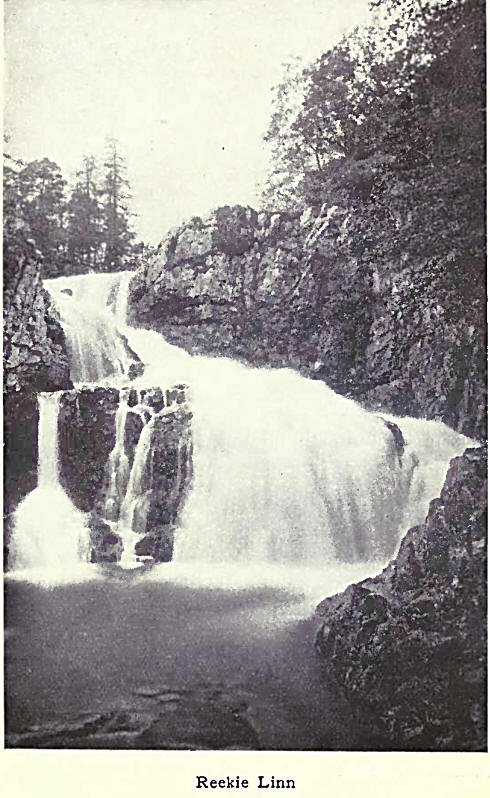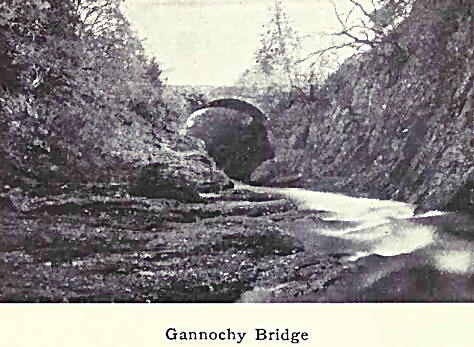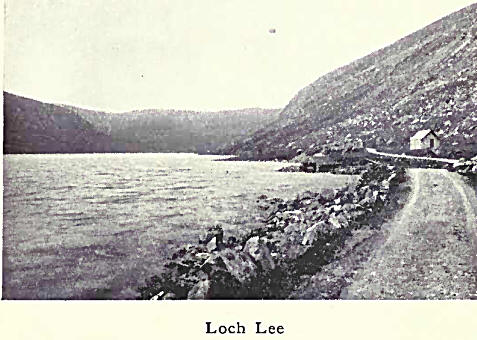|
Though the river Tay
belongs to Perthshire, one of its main affluents, the Isla, flows
for at least two-thirds of its course through Angus. Forty-five
miles from its junction with the Tay, far up in the heart of the
eastern Grampians, the Isla finds its source in two streams, one
descending from the corry of Caenlochan and the other from Glen
Cannes. At first it flows due south through a narrow, tortuous glen,
but soon turns south-east through a wider valley. Further on, it
plunges into the Den of Airlie, one of the grandest ravines in this
part of Scotland. After curving to the west, the Isla winds through
the heart of Strathmore to join the main stream. Many hill burns, as
the Brighty and the Newton Burn, pour into the Isla. Lower down it
receives the Burn of Alyth and the Melgum. The Dean from the Forfar
Loch, and the Ericht, known in one of the main branches of its upper
course as the Blackwater—a stream nearly as long as the Isla itself
and flowing through a valley parallel to it—are tributaries that
join it in the Strath.
The Reekie Linn in
the Den of Airlie is as imposing as any waterfall in the country. At
this point the river, which has for some distance been hemmed in by
precipitous banks, plunges over a rock 80 feet high in a cataract
which when swollen is unbroken in its descent. The smoke-like spray
which then enshrouds it gives its name to the fall. Scarcely less
remarkable is the boiling Slug of Auchrannie, a rocky gorge of the
river about a mile farther down the Den of Airlie. The waters of the
Melgum flowing through the Loch of Lintrathen, from which Dundee
derives its main water supply, have been partly impounded to
increase the resources of that fine natural reservoir.

The central river of
Forfarshire is the South Esk, a stream entirely within the county
limits. It rises in Cairn Bannoch (3314 ft.), the extreme
north-western point of Angus, is joined by a small hill burn that
carries off the overflow of Loch Esk, often mistaken from its name
as the source of the river, and under the sublime heights of Cairn
Broadland, the Scorrie, and the Red Craig, receives the White Water
from Glen Doll. The valley of the South Esk is known in its upper
reaches as Glen Clova. For the first half of its course the river
flows south-east. At Cortachy it enters a rocky channel and a richly
wooded district, and after being joined by the Prosen, it sweeps
eastwards into Strathmore and winds in a tranquil course to the sea,
which it reaches through the wide estuary of Montrose Basin. Its
main affluent on the left bank is the Noran from Glen Ogil. About
six miles from Montrose Basin the river leaves the wooded policies
of Brechin Castle and curves round the southern part of the ancient
ecclesiastical city of Brechin. Lower down it passes the noble deer
park and grounds of Kinnaird Castle.
Like the Isla and the
South Esk, the North Esk is partly a highland, partly a lowland
stream. For about half its course it forms the boundary of
Kincardine. Its twin head-waters, the Lee and the Unich, join each
other under the precipices of Craig Maskeldie, and after flowing
through Loch Lee it receives the Mark on the left and the Eftock on
the right. The valley of the Tarf, the main highland tributary of
the Esk, spreads out like an extended hand to the north, each finger
representing a hill burn descending from the frontier heights of the
county. At the point where the Tarf joins the river is situated the
hamlet of Tarfside, the headquarters of Upper Glen Esk. Towering
above it in the west is the Craig of Migvie or Hill of Rowan crowned
with an imposing monument to Fox Maule, Earl of Dalhousie. After
forming a huge S-shaped curve, the axis of which lies east and west,
the Esk enters a somewhat wider part of the glen, which it follows
until it plunges into a ravine similar to those at Airlie and
Cortachy. This, the most romantic part of its middle course, is
crossed by the main road at the Gannochy Bridge, which presents fine
views both up and down the river. Thereafter the Esk passes the
pretty village of Edzell and continues its devious course to the
sea, three miles north of Montrose. The Water of Saughs, known lower
down its course as the West Water, is the longest tributary of the
North Esk and joins it on the right bank a little below Edzell. The
Cruick, a shorter stream flowing almost parallel to the South Esk,
enters it in the grounds of Stracathro House.

Besides these larger
rivers, four smaller streams fall to be noticed. The Lunan, with its
tributary, the Vinney, rises in a chain of lochs east of Forfar and
has a short course to Lunan Bay. The Brothock, a still smaller
rivulet, enters the sea at Arbroath, a contracted form of
Aberbrothock. A little to the west, the Elliot passes by Carmyllie
and Arbirlot. The Dighty has a much longer course. It rises in the
Lochs of Lundie under the central Sidlaws, flows east through
Strathmartine and enters the lower estuary of the Tay at Monifieth.
The lochs of
Forfarshire are less numerous and less extensive than they were,
say, a hundred years ago.
Within that time many
have been drained, with the double advantage of increasing the
farming land and improving the climate of the county. In the case of
lochs into which streams flow, silt is always being deposited, which
through time decreases the area of the sheet of water. On the other
hand, a loch is sometimes artificially enlarged and deepened for the
purpose of supplying the wants of a town. Of this a notable instance
is Lintrathen Loch.
There remain a few
small lochs in the Lundie district. One by the roadside at
Tallybaccart is the haunt of wild fowl and gulls. One or two pretty
lochs lie deep in the neighbouring woods and at the head of
Strathmartine is the small circular Pitlyel Loch in the midst of
charming scenery. The Long Loch of Lundie directly under the highest
parts of the Crags has been leased by the bleachers and millers of
the Dighty, and at certain points its banks have been raised so as
to secure at all seasons a sufficient supply of water for commercial
purposes.
The Loch of Forfar,
one mile and a quarter long by a quarter of a mile wide, lies close
to the county town. Its surplus waters have been led into the Dean
and so to the Isla. St Margaret’s Inch, an island in this loch, was
the site of a religious house founded by Alexander II. To the east
of Forfar stretches a chain of small lakes— Fithie, Rescobie, and
Balgavies—-which are drained by the Lunan river.

The finest lochs are
in the highland portion of the county. Every glen has its tarn.
Drumore is under the heights of Mount Blair in the extreme west. In
Glen Isla there is Auchintaple. Loch Esk lies high amongst the
corries at the head of Glen Clova, and on the east side of the same
glen, not far from the Kirkton but 1300 feet above it, are two deep
mountain lochs, Brandy and Wharral, lying each under an amphitheatre
of sterile and precipitous rocks. To the east of the Wharral ridge
is Stony Loch, the source of the Water of Saughs. In Glen Esk there
are two small lakes bearing the name of Carlochy, one in Glen Mark
and the other in a deep embrasure of Craig Maskeldie. Loch Lee is,
however, the chief mountain lake of Angus. A mile and a quarter in
length by half a mile in breadth, it is in its noble surroundings a
typically highland loch. Heather clad or bare rocky mountains rise
to a great height on its two sides and its upper end, and except
where the Lee is gradually silting it up on entering its waters, it
is of great depth. Like so many more of the mountain lochs of the
district, it is stocked with fine trout.
In 1870^ the Water
Commissioners of Dundee were empowered by Act of Parliament to
purchase Lintrathen Loch as a source for supplying water to their
city.
Where bleach works
and mills have not contaminated the purity of their waters, the
lakes and streams of Forfarshire afford excellent trout fishing,
which is particularly fine in the highland section of the county. |

